This was published 7 months ago
The family holiday that took a sickening turn and ended with a father behind bars
An Australian man on holiday with his wife and three children began messaging a stranger on social media. When he returned home, officers swooped.

Manila’s Red Light District.Credit: Daniel Ceng
Makati: One warm December afternoon, Gary Richmond-Jones boarded a flight from Sydney to Manila with his wife and three children.
Eight days into his Philippines holiday, he downloaded encrypted messaging app Telegram to contact a stranger who had messaged him on X, formerly Twitter, advertising child abuse material and leaving a number.
“Hey, saw your Twitter. Interested. Pinay girls loli,” Richmond-Jones wrote.
The 57-year-old recently told the NSW District Court that “Pinay” referred to Filipino females and “loli” to underage girls.
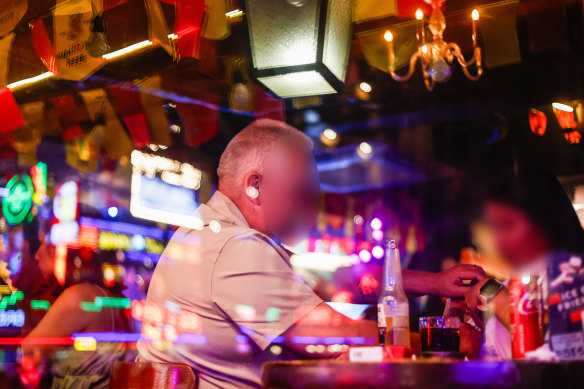
Older foreigners find younger Filipino women and girls in Makati.Credit: Daniel Ceng
Richmond-Jones is one of many Australian men fuelling the demand for online child abuse material in the Philippines. This masthead recently reported Australia is a main contributor to the trade that has left local rescue shelters full of scarred children.
Australian and Filipino authorities have stressed the challenges in curbing this insidious industry that preys on society’s most vulnerable, as human rights advocates call on online giants to follow new Australian government standards to protect children from online sexual abuse.
‘What price for the girls?’
After Richmond-Jones requested pictures of underage girls on December 26, 2022, agreed facts reveal he received a thumbnail preview of videos appearing to show adults abusing children and a price list for the different exploitation material, ranging from $3.80 to $51.
“Looks good,” Richmond-Jones, a car sales manager from Mackay in Queensland, responded.
“I will send as soon as I can.”
After discovering he could avoid paying for the material “by card” by cashing in at a local Philippines 7-Eleven’s loyalty program, he wrote “Is it possible to find real 13-15 in Manila?“, telling the court that he was contemplating engaging in sexual activity with a real child.
“Yes bro, where are you rn [right now]?” the person responded.
He said where he was in the Philippines and that he would be Manila on his way home.
“Before I fly home, I have a day to find,” he wrote.
Three days later, Richmond-Jones sent the person a text reading “I arrive next Friday”. He received nine photos of girls aged between 12 and 16, many with cartoon symbols hiding their breasts.
“All gorgeous, but [redacted name] would be the pick,” he wrote, referring to a 12-year-old girl.
“What price for the girls? I need to sneak money away from my wife’s view.”
In response to a list of different “services”, Richmond-Jones wrote “fantastic, I will book a hotel”.
When the day came to meet them, Richmond-Jones backed out of his plan, the court heard, and he stopped responding to the person’s messages.

The blinding lights of the Red Light District.Credit: Daniel Ceng
Upon landing back in Australia, border force officials searched his phone and found child abuse material. A further AFP investigation uncovered messages discussing his intention to abuse children. He later pleaded guilty to preparing and planning to engage in sexual activity with a child under 16 outside Australia as well as importing child abuse material. He is due to be sentenced in August.
Giving evidence during a sentence hearing, Richmond-Jones said he had come to “deeply regret” his “completely unacceptable” actions, saying “child abuse is never OK”.
“It was a wake-up call to myself that I was even considering it,” he said.
“If it had been my children, I certainly would’ve been looking for the people involved to be prosecuted and brought to justice. I look at my children and there is an innocence that shouldn’t be taken away.”
He said he tried to “justify” his behaviour by the fact it was “just online” but realised his actions were putting children at risk.
“The only way to stamp it out is to stop it from happening and in this case it had to start with me not proceeding with what I was planning to do,” he said.
Yet, the innocence of an estimated half a million Filipino children was exploited in 2022, and there is no simple solution to curbing Australia’s skyrocketing demand for the unimaginable acts.
Manila’s Red Light District: Where ‘tourists’ come to meet local women – and children
A young woman in a tight yellow mini dress stands confidently on a corner of P. Burgos Street in the city of Makati, Metro Manila’s financial hub and home to the city’s Red Light District.
She catches the eye of an older white man in a blue-and-white checkered shirt and whispers in his ear. They walk off together into the street’s blinding lights.

Foreigners meet locals at P. Burgos Street in the city of Makati.Credit: Daniel Ceng
The nightlife hotspot is home to many restaurants and bars. It is also Manila’s sex tourism centre. Behind the doors of some of the more discreet venues, older men from other countries are known to seek out Filipino women – and children – for sexual gratification.
While child abuse hidden amidst the traditional face-to-face “sex tourism” is still prominent in the Philippines, it sits alongside the growing problem of pay-per-view live-streamed abuse, Manila-based Australian Federal Police child protection officer, Detective Sergeant Daisie Beckensall explained.
“During the COVID pandemic, worldwide, we saw an increase of people online and an increase in live-distance child abuse … COVID made it so much easier for offenders in Australia to contact the children, and we’re seeing that continue,” she said. “Now with the pandemic being finished, all the international borders are open. We are seeing people come to the Philippines as well to abuse children. So it’s a mix.”
Beckensall said payments for live-streamed abuse typically ranging from $20 to $50 “per show”. Relatives are often the ones abusing the children, claiming the money is desperately needed for food and shelter.
“It can be difficult to work in, knowing that there is a minor victim at the other end of the abuse,” she said.
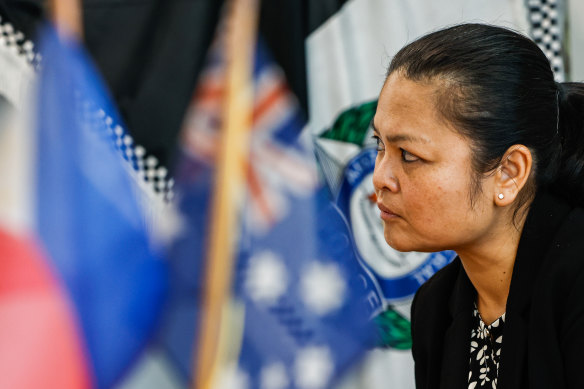
Detective Sergeant Daisie Beckensall, AFP Liaison Officer (Child Protection).Credit: Daniel Ceng
While the AFP does not have jurisdiction to do on-the-ground policing in the country, behind the scenes, Beckensall and her team have saved hundreds of children, receiving referrals from Australian colleagues and working with analysts to help Filipino authorities build up a strong enough case to search the homes where they suspect these crimes are taking place.
One challenge is that Philippine law requires a higher bar for search warrants than Australian law; a major advantage is their penalties are harsh, with some offenders receiving life imprisonment.
But only one Australian is known to have been convicted in a Filipino court for child abuse – Peter Scully, often described as “the world’s worst paedophile”.
Scully was already sentenced to life in prison in the Philippines for human trafficking and rape when he received a 129-year sentence for sexually abusing dozens of children as young as 18 months in 2022.
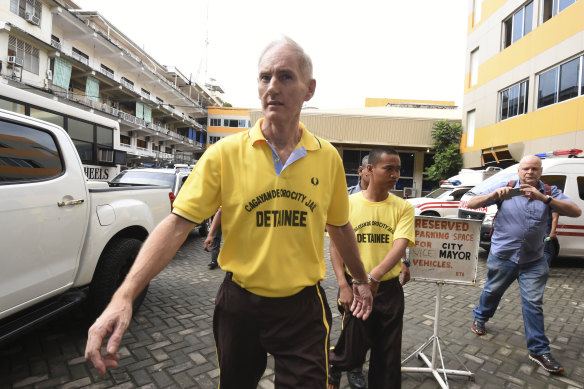
Australian man Peter Scully is often described as “the world’s worst paedophile”.Credit: Kate Geraghty
Most Australians who exploit children overseas are arrested upon returning home, just as they begin to believe they have escaped justice.
Australian Border Force officials can legally search phones at random at airports, often uncovering child abuse material and incriminating conversations.
Investigators from the AFP’s joint child exploitation team then search the suspect’s home and regularly discover other electronic items with more exploitation content.
This happened to Melbourne man Missaka Senarath, who preyed on impoverished children in the Philippines by requesting naked photos and videos online in exchange for money, before travelling to the country and abusing a nine-year-old girl there.
The 46-year-old was found with child abuse material on his phone upon returning to Melbourne Airport on September 23, 2022. AFP officers later found a self-produced video of his abuse and over 900 files of child abuse material on his electronic devices at home.
He was jailed for nearly 14 years in June.
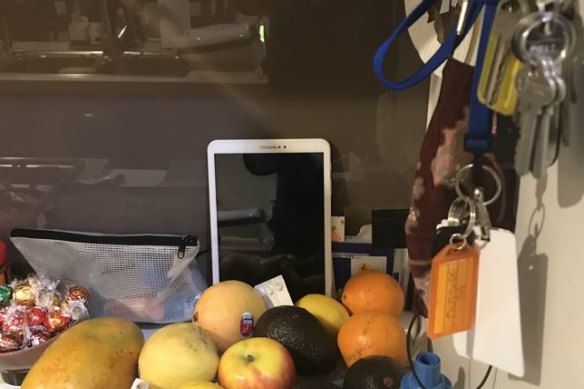
One of many devices owned by Missaka Senarath which contained child abuse material.
Local authorities, tipped off by the AFP, rescued two nine-year-old girls from the Filipino home where the abuse occurred.
As is sadly so often the case, the kids were betrayed by the person who was meant to protect them. Their mother facilitated the abuse, and was recently sentenced to 15 years’ prison in the Philippines.
In 2019, the AFP, UK National Crime Agency, and International Justice Mission (IJM) founded the Philippine Internet Crimes Against Children Center (PICACC). From February 2019 to June 5, 2024, PICACC conducted 252 investigations, rescuing 733 victims and charging 158 facilitators. AFP-referrals accounted for 58 offenders charged and 244 children rescued.
Calls for online industry to do more to curb ‘demand-driven’ crimes
While an estimated 1 in 100 Filipino children were sexually abused by traffickers in 2022 to sell child exploitation material globally, the real number is likely far higher. Children are often unlikely to report abuse by their parents – or may not know how to – one of the biggest roadblocks to arresting offenders.
Executive director of a new online exploitation office under the Filipino government’s Inter-Agency Council Against Trafficking, Margarita Magsaysay, said parents tell children the sexual acts are needed for food.
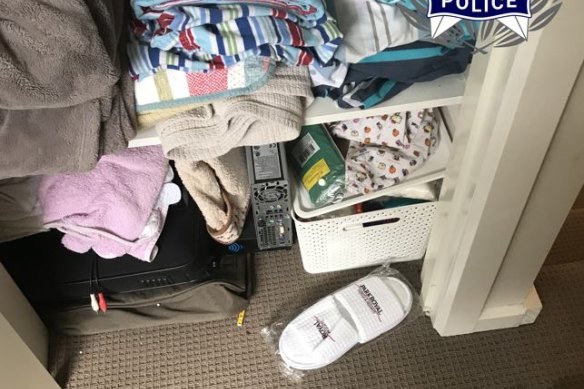
More child exploitation material was located on computers hidden in Missaka Senarath’s wardrobe.
“They say ‘Just do this, just for today’. But the next day, they do it again,” she said.
“If the demand online was not there, the supply would not be there.”
Magsaysay wants stronger regulations for tech giants and payment platforms that enable the dissemination and transactions.
Echoing those calls is David Braga, the chief executive of International Justice Mission Australia, an organisation working to counter online sexual exploitation of children.
He said research shows viewing online child sexual abuse can lead to crimes being committed in person, creating a “domino effect” of increasing violence.
Recent research by the University of Edinburgh’s global child safety institute Childlight found 7.5 per cent of Australian men have self-reported behaviour in their lifetime that could be classified as online child sexual abuse offending – and they were a top driver of this crime in the Philippines.
An IJM study found most traffickers communicate about and exchange this material in plain sight on social media and messaging sites, not on the dark web.
Last month, Australia’s eSafety Commissioner Julie Inman Grant strengthened industry standards, requiring online communication services to implement systems, processes and technologies to disrupt and deter child sexual abuse and exploitation material on their services.
Braga welcomed the change, but said providers could still claim it is not technically feasible to do this, with the eSafety commissioner lacking powers to push back.
He urged the commissioner to “close the self-exemption loophole” and the online industry to cooperate and help protect children, “wherever they are in the world”.
with Daniel Ceng and Aram Lascano
If you or someone you know is affected by sexual assault, domestic or family violence, call 1800RESPECT on 1800 737 732. Crisis support is available from Lifeline on 13 11 14.
Start the day with a summary of the day’s most important and interesting stories, analysis and insights. Sign up for our Morning Edition newsletter.